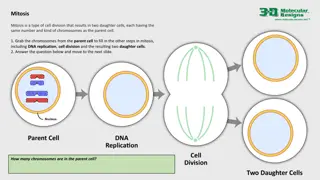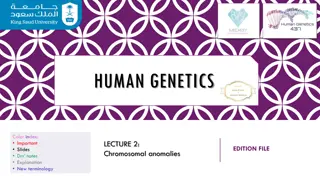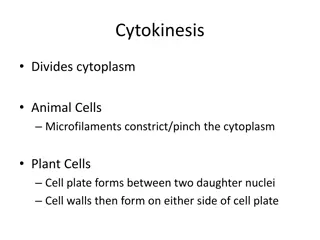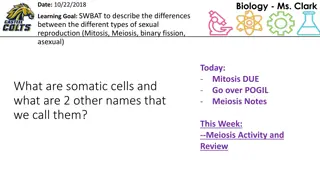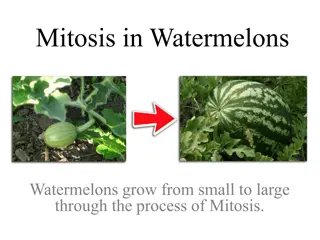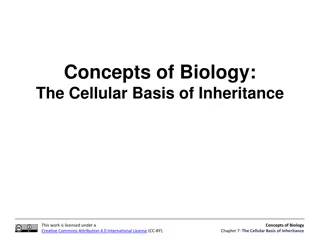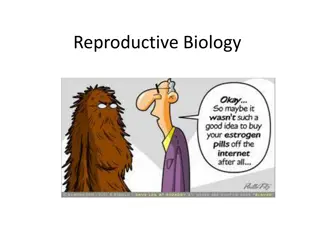Understanding Meiosis: Key Concepts in Biological Evolution
Meiosis is a crucial process in organisms, involving the formation of haploid gametes with unique allele combinations. This process ensures genetic diversity through crossing over and independent assortment, leading to variations essential for evolution. The significance of homologous chromosomes, diploid and haploid cells, and fertilization in sexual reproduction are explored, highlighting the diversity generated through meiosis. Gamete production and the intricate stages of meiosis are detailed to provide a comprehensive understanding of genetic inheritance and evolution.
Download Presentation

Please find below an Image/Link to download the presentation.
The content on the website is provided AS IS for your information and personal use only. It may not be sold, licensed, or shared on other websites without obtaining consent from the author. Download presentation by click this link. If you encounter any issues during the download, it is possible that the publisher has removed the file from their server.
E N D
Presentation Transcript
Meiosis Unit 2: Organisms and Evolution Advanced Higher Biology Miss A Aitken
National 5 Re-Cap Haploid: One set of chromosomes 23 All gametes (sex cells sperm and egg) are haploid Diploid: Two sets of chromosomes 46 (or 23 pairs) All other body cells are diploid (e.g. skin cell, muscle cell)
Homologous Chromosomes The chromosomes in each set are homologous. This means they are matching/the same Same size Same genes in the same loci (latin: place/location) Same centromere position Although they have the same genes in the same loci, the alleles (forms of gene) may be different.
Sexual Reproduction Fertilisation is the combining of two haploid nuclei of two gametes, which forms a diploid nucleus. This combining of two haploid genomes produces a new combination of alleles and increases variation.
Gamete Production Gametes are produced by meiosis in a gamete mother cell. Meiosis happens in the interphase of the cell cycle. During S phase, the homologous chromosomes duplicate. Gamete mother cells are diploid cells so after replication, there will be two sets of two chromosomes (92). Meiosis can then occur to make 4 haploid gametes with 23 chromosomes each.
Meiosis 1 Similar pattern to mitosis Includes crossing over and independent assortment
Process of Meiosis 1 Before meiosis 1, in S phase, chromosomes duplicate. During meiosis 1, each duplicated pair lines up with their homologous partner, so that they are aligned. Chiasmata (crossing points) form at random positions between the homologous pairs, allowing the crossing over of sections of DNA between homologous chromosomes. (more later)
Process of Meiosis 1 (cont.) Nuclear membrane then breaks down so that microtubules from the centrosomes can connect with the centromeres of the chromosomes. The microtubules form spindle fibres linking across the cell and this aligns homologous chromosomes along the cell s equator. Chromosomes position themselves randomly along the equator, regardless of which parent they came from. This is called independent assortment. (more later)
Process of Meiosis 1 (cont.) Microtubules of spindle fibres shorten and pull on the centromeres so the homologous chromosomes separate to opposite ends of the cell. A nuclear membrane then forms around the chromosomes, and cytokinesis (division of cytoplasm) forms two new cells. At this point, cells are still referred to as haploid even though they have two sets of genetic information. This is because they only have one copy of each homologous chromosome.
Meiosis 2 The nuclear membrane breaks down again Microtubules are sent out from centrosomes and bind to the centromeres of each chromatid. Spindle fibres align the chromosomes across the equator of the cell.
Meiosis 2 (cont.) Microtubules shorten and pull on the chromatids, separating them to opposite ends of the cell. Immediately after being separated, chromatids are referred to as chromosomes. This is because they can be seen separately through a microscope. The new chromosomes group together and a nuclear membrane reforms, and cytokinesis occurs. 4 genetically different haploid cells have been produced.
independent assortment independent assortment During meiosis I homologous chromosomes pair up along the equator of the cells in a random and independent manner. Independent assortment results in the production of gametes with varying combinations of maternal and paternal chromosomes.
independent assortment independent assortment The number of different combinations produced by independent assortment can be calculated using the formula 2n-where n is the haploid number. 23 = 2x2x2 = 8
independent assortment independent assortment Independent assortment results in new combinations of allelesand increased variation.
recombination frequency recombination frequency The recombination frequency indicates the distance between the linked genes.
gene mapping gene mapping The recombination frequencies can be used to map the position of linked genes on a chromosome. Bozeman gene mapping
gene mapping gene mapping linked genes % RF BZ 12 RZ 7 BS 5 BR SZ plot two genes that are furthest apart 5 17 S Z 17 S B Z 5 12 S B R Z 5 7
gametic gametic meiosis meiosis In many organisms, gametes are formed directly from the cells produced by meiosis gametic meiosis.
zygotic meiosis zygotic meiosis In other groups, mitosis may occur after meiosis to form a haploid organism; gametes form later by differentiation zygotic meiosis.


